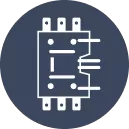Pump controls refer to the components that move the pumps. They receive input from sensors like pressure switches or level probes and then switch pump motors on or off or vary their speed. That kind of automation maintains pressure, flow or liquid level within safe limits automatically without human beings having to read gauges continuously. Apart from executing operations, they also protect motors from burns due to dry running, over current, or excessive cycling.
Types of Pump Controls
Different jobs call for different control methods.
1. On/Off (Binary) Control
For on/off control, the pump just turns on when a low threshold is reached (for pressure or level) and off when a high threshold is reached. It relies on ordinary relays and switches. This setup is straightforward to install and maintain. It is suitable for small water wells, basic irrigation, and simple storage tanks.
2. Pressure Control
Maintaining system pressure between selected limits is known as pressure control. When pressure drops too low, the pump turns on; when pressure climbs too high, the pump turns off. This process is used frequently in water supply, booster, and fire protection systems, where continuous pressure is needed.
3. Flow Control
Flow control employs flow meters or sensors to follow the flow rate of liquid travelling inside the pipe. The controller varies the speed of the pump or cycles the pumps to achieve a specific flow rate. It is frequently applied to chemical dosing, cooling circuits, and any application where flow needs to be accurate.
4. Level Control
Level control protects from overflow or dry run. Float switches or probes sense high and low liquid levels in tanks or sumps. This is standard practice in wastewater lift stations, holding tanks, and industrial storage vessels.
5. Timing (Cycle) Control
Timing control operates pumps according to a schedule instead of based on sensor feedback. It does so in preprogrammed intervals of run and rest. This is useful in applications like drip irrigation, pool filtration, or for any process with predictable demand patterns.
6. Variable Frequency Drives (VFDs)
VFDs are the most precise because of their ability to vary motor speed. They adjust pump output to demand, reducing energy consumption and wear on machinery. They also offer soft starts that limit inrush current and promote motor longevity. Variable-frequency drives (VFDs) are more suited to variable-load systems such as HVAC chilled water loops and large booster stations.
7. Soft Starters
Soft starters gradually increase voltage and thus allow the pump motor to gradually come to its full speed. They don't control speed the way VFDs do, but they still protect the motor and plumbing from shock loading. Soft starters are typically used for medium and large-sized motor applications where full-speed operation is necessary but large inrush currents need to be controlled.
8. Specialized Controls
Some specific types of pumps, including metering pumps, peristaltic pumps, and diaphragm pumps, use custom control methods. For instance, metering pump controllers control stroke length and speed for accurate dispensing in laboratory and medical equipment.
Key Features of Modern Pump Controls
The pump controls of today do more than simply start and stop a motor. They can add intelligence and protection to allow processes to run better and longer.
- The motor is stopped if it draws too much current or overheats.
- Senses the loss of fluid (by pressure or the flow drop) and cuts off the pump before damage starts.
- Log errors (e.g., phase loss/sensor malfunction) for faster troubleshooting.
- Allows status checks, set-point changes and alarm resets from a centralized system or mobile device.
- Integrates with building or process control networks through industry protocols (e.g., Modbus, BACnet).
- Provides touchscreens or web dashboards that streamline setup and operation.
- Records performance data for energy audits, maintenance planning, and efficiency improvements.
Common Applications
Pump controls can be found in almost all industries requiring safe and reliable fluid handling. Below are some typical uses.
Water Supply & Booster Systems
They keep water pressure in houses, offices and high-rise buildings uniform. There are controls to prevent rapid cycling during peak demand and to ensure a steady supply.
Wastewater & Sewage Lift Stations
They handle effluent pumping to treatment facilities. Level controls avert overflows, and remote monitoring enables operators to respond quickly to blockages or failures.
Irrigation & Agriculture
Farm watering automation through flow and pressure controls. Timing controls operate sprinklers at ideal times. VFDs save energy when the flow demand varies during the day.
Industrial Processes
In factories, exact control of flow and pressure keeps reaction, mixing, and heat exchange in line. Fault diagnostics and data logging help to achieve high uptime and product quality.
HVAC & Chilled-Water Loops
Pump speed is adjusted via VFD to match the heating or cooling load. VSDVs decrease energy consumption compared to running pumps at full speed with valve throttling.
Fire Protection
Fire pumps are set automatically when an alarm goes off using control panels. They are sufficient to maintain system pressure to operate sprinklers and hydrants.
How to Choose the Right Pump Control
Selecting the best control method and equipment depends on several factors:
- Pump and Motor Specs: Ensure compatibility between control and motor size, voltage, and enclosure type.
- Process Requirements: Identify if pressure, flow, level, timing, or variable-speed control is needed for the application.
- Environment: Choose NEMA or IP ratings for indoor, outdoor, or corrosive settings.
- System Integration: Ability to communicate with existing building or plant control systems and protocols.
- Energy Goals: For variable loads, VFDs can be the most cost-effective energy-saving device. Seek energy-monitoring capabilities.
- Maintenance Needs: Check on how easy it is to update firmware, whether there is local support available, and the availability of spare parts.
- Budget vs. ROI: Weigh initial costs against long-term savings in energy, repairs, and downtime.
Installation Best Practices
Proper installation allows controls to work as intended and increases longevity.
- Find a clean, dry area with good airflow. Keep away from direct sunlight or sources of heat.
- Follow local codes and the manufacturer's diagrams. Ensure the use of correct wire sizes, surge protection, and grounding.
- Install pressure, flow, and level sensors exactly as OEMs recommend to prevent false readings.
- Test set points, alarms, and interlocks after wiring. Check overload, dry run and emergency stop functions.
- Give operators up-to-date manuals, wiring schematics and practical training for normal checks and emergency situations.
Final Thoughts
Pump controls are important for the safe, efficient and reliable operation of pumps in various types of systems. Whether it is for control of water supply in a building, the control of waste-water, or the control of industrial processes, the correct control setup makes a huge difference.



